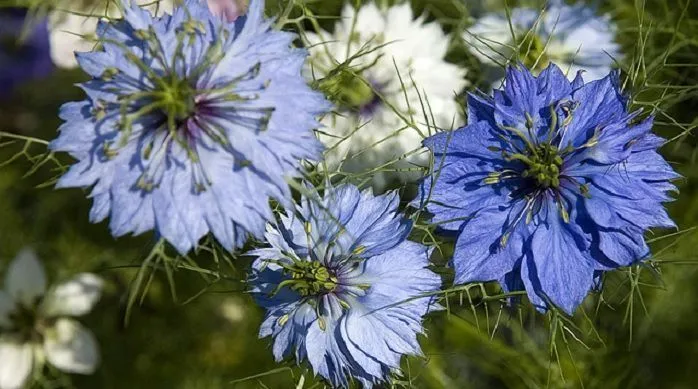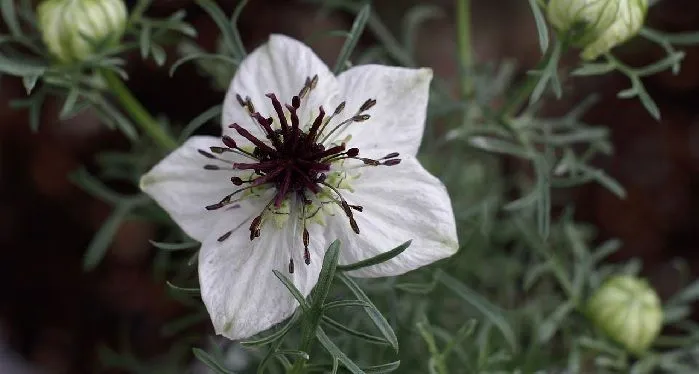We enter again into the world of medicinal plants, and this time it is the turn of a well-known crop, nigella sativa or as it is commonly known, black cumin.
A plant used since ancient times from which practically everything was used (seeds included) and that today still continues to use many of its properties or have been derived to gastronomic use.
Table of Contents
Description of Nigella sativa and where we can find it
Nigella sativa is a medicinal plant, family Ranunculaceae (a family that stands out for its medicinal and phytochemical properties), which lasts all year round and stands out for having a whitish flowering with large sepals.
It does not usually exceed 50 cm in height (rarely reaches 60 cm) and the color of its leaves and stems is grayish green. For the harvest of the fruit, housed in a capsule, you must first wait for it to dry or change color, during the ripening process, to extract the seeds, small and gray.
Ornamentally black cumin has not been used, since its flowering, even having a fairly prominent flower diameter, is not very intense and does not last long. Rather, it can be associated with inexperienced eyes as an adventitious herb.
As a curiosity, if we get very close to the flower and smell it, it will remind us of nutmeg or a touch of pepper. This will cause some civilizations to use the plant to replace pepper, when there was a shortage. But hey, we’ll figure that out later.
Its many uses have achieved Nigella the Arabic approval ‘Habbatul barakah’, which means the seed of blessing.
How to grow black cumin
Although it is a very rustic plant, which grows spontaneously in many countries of Asia and some areas of the Mediterranean, we are going to teach you some basic characteristics of its cultivation.
Climatology
The Mediterranean climate is usually ideal, climatologically speaking, for the cultivation of Nigella sativa. Mild winters and warm summers, without excessive rainfall and possible long periods of drought.
It usually needs great sun exposure and light, withstanding a wide range of heat and cold.
Soil characteristics
It usually grows in environments of basic pH or alkaline soils. It does not have a characteristic type of soil structure, and this plant has been seen to grow in both sandy and clay soils.
However, within this it is important that there is good drainage, because the roots of this plant are not very adapted to excessively humid environments and their roots suffer a lot.
Water and fertilizer needs
The ideal for this plant are deep and spaced waterings, which can often occur due to the type of sporadic and torrential rain in many areas of the Mediterranean.
The contribution of organic matter and the contribution of the plant improves its ability to produce new roots and improves the characteristics of its essential oils.
Multiplication
The multiplication of black cumin can be done by seeds, not being excessively difficult, since in rustic lands, expansion through the wind is effective.
In this article you can see how to multiply other medicinal and aromatic plants.
Where does this plant come from as a medicinal use?
Related names
- Black cumin
- Ajenuz
- Blessed seed
With regard to names, we often say so. It is better to use the scientific name as it is possible that some common names make species mix and confuse.
For example, the name black cumin also applies to another plant Bunium bulbocastanum, closely related to the cumin plant and which is also known as black caraway or large pignut.
The origin of Nigella sativa it is one of the countries currently occupied by Turkey and Iraq, although it can be found in some areas of the Mediterranean. At least in Spain, it is not documented, but other related varieties are documented, such as those described in the botanical museum of Madrid.
- Nigella damascena
- Nigella gallica
- Nigella papillosa
- Nigella atlantica

Facts of Nigella sativa
We always prefer to evaluate the content of chemical elements to study their behavior in the face of the relief and cure of certain problems. Therefore, we know that some of the oils of Nigella sativa are formed by:
- Thymoquinone (30-48%)
- Melantine
- Damascenin
- Tannins
- Linoleic acid
- Thymohydroquinone (7-15%)
- Nigelone
- Nigillin
- Terpineol (2-7%)
- Omega 3 and omega 6
- Thimol
- Carvacrol (6-12%)
It also contains a large number of microelements and amino acids. Its nutritional composition is distributed as follows:
- Proteins (26.7%)
- Fiber (8.4%)
- Fats (28.5%)
- Carbohydrates (24.9%)
It contains a large amount and variety of unsaturated fatty acids, such as linoleic acid (50-60%), oleic acid (20%), eicodadienoic acid (3%) and dihomolinoleic acid (10%).
Of thymoquinone, one of the main components of black cumin there is a curious reference. It turns out that Nestlé has investigated (and in the process of patenting) with the use of this compound to treat certain allergies to the elements.
However, thymoquinone is not exclusive to the black cumin plant but we can find them in other much better known species such as fennel.
To Nigella sativa numerous medicinal properties are attributed to it, described below:
Breathing problems
The seed extract is bronchodilator and is used to relieve asthma symptoms. This effect is due to the thymoquinone, it works by reducing wheezing (swelling of phlegm in the airways) and acting as a potent anti-inflammatory.
Antibacterial and antifungal properties
Some components of this plant, from the extract of the black seed have antibacterial and antifungal effects. They can be applied topically (by ingestion) or in application on the skin, where there have been very few cases of allergic reactions.
Prepared in oil, it has skin regenerating properties and can be used as a multipurpose.
Applied to the skin, it has a regenerating, moisturizing, protective, soothing and soothing effect. anti-inflammatory properties.
This is due, again, to thymoquinone, which is a potent antiseptic of natural origin, with antioxidant properties.
These antiseptic effects can also be found in the properties of thyme.
Some research has shown an inhibiting effect of Staphylococcus aureus, a bacterium that accuses respiratory infections, conjunctivitis, meningitis or pneumonia.
Protection against diabetes
Recent studies have shown that consuming 2 grams a day of black cumin reduced blood sugar levels for type 2 diabetics, as well as a reduction in insulin resistance and increased beta cell function.
Hypotensive effect
To reduce high blood pressure in chronic patients, consuming 100 to 200 mg of seed extract 2 times a day for at least 60 days had a hypotensive effect and offered significant results for patients with mild hypertension.
Cancer-reducing properties
Currently there is a very strong line of research where they relate Nigella sativa against the progression of certain types of cancer.
For that matter, antitumor and antiangiogenic TQ fectos have been demonstrated in osteosarcoma, breast cancer, and other carcinomas.
Pepper substitute
We all know the route of pepper and the difficulties that often existed to obtain this raw material. Its use was well known because the preservation of meats was not the most appropriate and they used many spices to mask the flavor, often in a state of decomposition.
When there was no pepper, the Romans replaced this element with the seeds, ground or not, of Nigella sativa.
Similarly, in Germany this seasoning was also used to mix with other types of seeds in the creation of breads.
Stomach and digestive protector
The black seed has been analyzed for its digestive and protective properties of the stomach against infections, incluse compared to leftover drugs known as omeprazole.
Black cumin extract controls the secretion of gastric acid and reduces the production of gastric mucin and total nitric oxide.
Reduces the effects of gout (uric acid)
Proven in numerous investigations, black cumin extract, ingested through its seed, reduces the levels of uric acid in the body.
Anticonvulsant properties
Since ancient times (this plant already had medicinal effects known since Charlemagne) it was used Nigella sativa for its anticonvulsant properties. In fact, this was demonstrated analytically in a study in 2007 in epileptic children with a problem with the intake of the usual drugs significantly reduces (not at the level of these drugs but significantly) the number of attacks.
Cholesterol and triglycerides
Black seed extract has been tested in rats topically for 3 months showing positive changes in their blood count (blood test), with a higher count in the volume volume of packed cells (PCV), in hemoglobin and decreased cholesterol levels and triglycerides.
Contraindications of Nigella sativa
Although it is often specified that there are no cotraindications of this plant, it is slightly toxic if we exceed the usual dose. Therefore, it is essential to consult with medical specialists if you want to take it during pregnancy.
Likewise, melantine (another compound present in the plant) is also toxic if we ingest a large amount, and the nigelline has a paralyzing effect.
This slight toxicity does not go beyond feelings of nausea and vomiting.

How to take black cumin
At present, there are many food supplements based on black cumin extracts. Mostly, the seed is taken advantage of, from which you can also make a very interesting oil with medicinal properties.
As a food supplement, we can take Nigella sativa as follows:
Black cumin oil
Administered in adults: 1 to 2 tablespoons of coffee a day, which can be mixed with any gastronomic dish or mixed in dessert with honey, coffee or milk.
Administered in children up to 10-12 years is enough with a tablespoon of coffee black cumin oil a day.
Cumin oil capsules
Information and references
Deanship of Scientific Research, King Abdulaziz University, Jeddah, Saudi Arabia (Grant No. 431-044)
Abel-Salam BK. Immunomodulatory effects of black seeds and garlic on alloxan-induced diabetes in albino rats. Allergol Immunopathol (Madr) 2012; 40 (6): 336-340.
Goreja WG. Black seed: nature’s miracle remedy. New York, NY: Amazing Herbs Press; 2003.
Al-Jassir MS. Chemical composition and microflora of black cumin (Nigella sativa L.) seeds growing in Saudi Arabia. Food Chem. 1992;45:239–242.
Nickavar B, Mojab F, Javidnia K, Amoli MA. Chemic al composition of the fixed and volatile oils of Nigella sativa L. from Iran. Z Naturforsch C. 2003;58(9–10):629–631.
Do you know more properties of Nigella Sativa?
